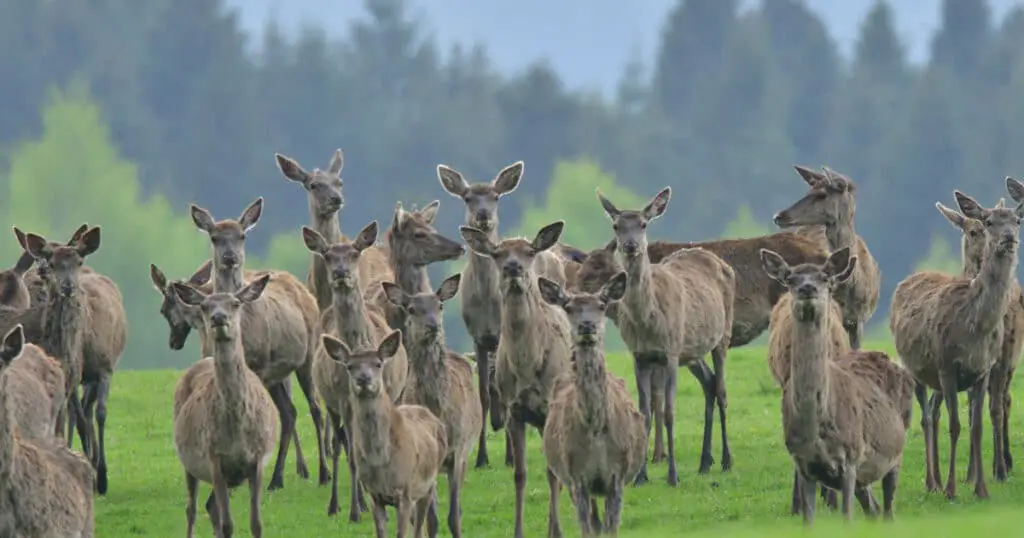Whether you’re a deer farmer or a hunter, you’ve got to understand the concept of deer density (population per acre). Deer population density affects many aspects of the environment, including the amount of food and space available. So how many deer per acre is ideal to maintain a deer herd’s health? What is the ideal stocking rate for deer if you’re raising them on your farm? Keep reading to find out.
Here’s an overview of what you’ll find here:
- Ideal deer population density chart
- Stocking rate for domestic deer
- Best types of land for domestic deer
- Average wild deer density per acre
- Permitted number of deer kills per acre
Deer Population Density Guidance Chart for Hunters and Farmers
Table of Contents
ToggleTo start things off, here’s a chart explaining essential deer population density information for deer farmers and hunters.
- If you’re a hunter, look at the Deer Hunting column to see how many deer you can usually hunt per acre of land on various acreages.
- If you’re a deer farmer, check out the Raising Deer (Farm) section to discover how many deer you can raise per acre on the same acreages.
| Acreage | Deer Hunting | Raising Deer (Farm) |
|---|---|---|
| 50 acres | About 5-6 deer per acre can be hunted on 50 acres of land | About 3-4 deer can be raised per acre on 50 acres of land |
| 100 acres | About 8-10 or more deer per acre can be hunted on 100 acres of land | About 10-12 deer can be raised per acre on 100 acres of land |
| 500 acres | About 18-20 deer per acre can be hunted on 500 acres of land | About 12-18 deer can be raised per acre on 500 acres of land |
| 1,000 acres | About 20 deer or more per acre can be hunted on 1,000 acres of land | About 20 deer or more can be raised per acre on 1,000 acres of land |
The number of deer you can hunt or raise per acre of land does vary by the land’s specific characteristics. However, the information in the chart above provides a good estimate or average that many deer habitats can support.
Keep reading to find a more in-depth look at the factors that play a role in how much space deer need. Let’s find out more below.
Stocking Rate For Domestic Deer
The main factors that affect how many deer you can raise per acre include:
● How many acres you have
● The level of vegetation on your land
● Habitat management
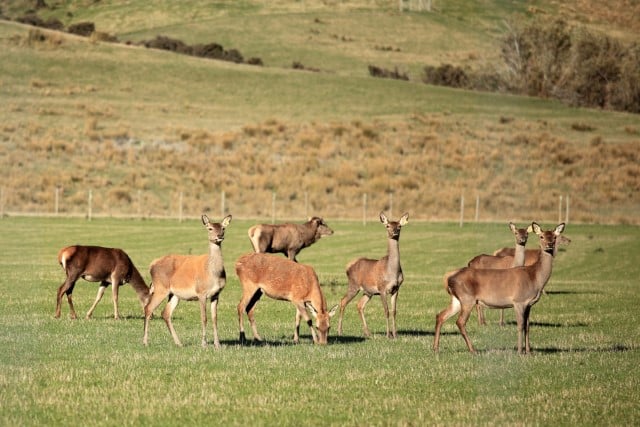
Deer need plenty of space to walk around and browse for food. Bucks are territorial, so they don’t do well in overly crowded areas.
Remember, however, that these are herd animals. Never isolate them.
Large groups of deer (or herds) need as many acres as possible to allow for adequate space.
Here’s a good rule of thumb: the more deer you have, the more land and vegetation you need.
The level of vegetation refers to the amount of available food the deer would have. Deer mainly feed on grasses, shrubs, and other woodland vegetation.
When there are more deer in an area, the likelihood of food being available decreases. If your land features large amounts of vegetation and will provide plenty of food for the deer, you should be able to raise large herds.
However, if your land has sparse vegetation, you might want to consider raising a smaller number of deer.
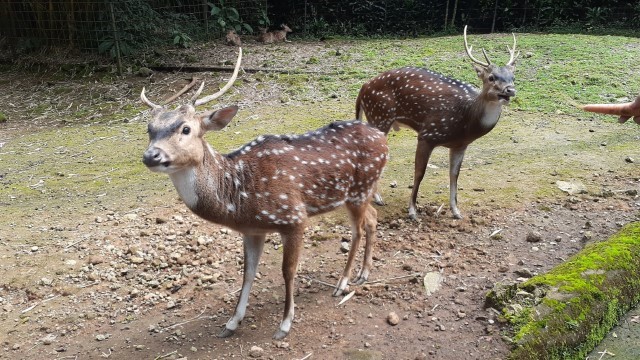
Lastly, habitat management is how you handle the land’s resources to raise the deer on your farm. When it comes to raising domestic deer, this mainly means making sure there is enough food and space.
For example, you usually shouldn’t raise deer on land with areas that have a lot of human activity.
The deer could interfere with the people and vice versa. It could end up in a dangerous situation.
Because of these factors, there isn’t a clear-cut answer on how many deer can survive in a given habitat.
Our chart shows the average, but the number of deer could be more or less depending on the unique characteristics and location of the habitat you have for your herd.
Best Type of Land For Domestic Deer
The best type of land for a domestic deer is somewhere that has lots of woods and brush nearby.
The forest should also be young since, as herbivores, the majority of a deer’s food comes from plants, and they need to be able to reach it.
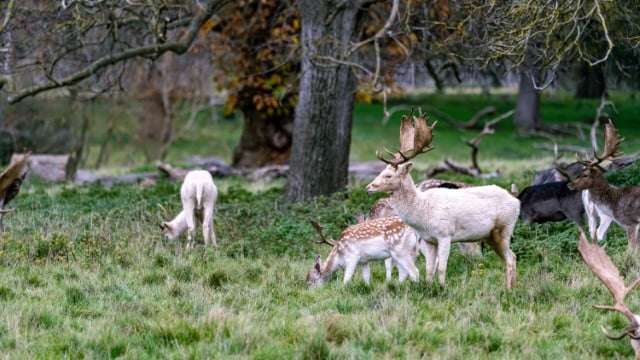
You can usually gauge a forest’s age based on how tall or short the trees are. The shorter they are, the younger the forest.
If the forest on your land is older, there is a way to make it habitable for deer. Logging and chopping down trees can help open up the forest canopy, allowing light to penetrate and grasses and other things the deer can eat will grow.
Some selective cutting will also provide a lot more space for the deer and make it easier to raise large herds.
If the habitat on your land is mostly wide open, including but not limited to fields and clearings, you can still make a quality deer habitat. You’ll just need to plant some trees and shrubs, or some annual food plots.
What deer need varies from season to season, and the deer species makes a difference as well. The diet of a white tailed deer is very different than that of a moose.
During the summer and spring seasons, most deer need lots of lush green vegetation to feed on.
They will have just finished a winter with scarce food, so they need to load up on as many nutrients as possible.
Protection is the most important thing when it comes to the winter and fall months. A few adequate methods of protection include:
- Planting tall plants, such as corn and pines
- Large trees
- Switchgrass fields
These can create good winter bedding areas for deer.
Deer will be able to survive comfortably if your habitat is able to provide most of these things.
Average Wild Deer Density Per Acre
Knowing the average wild deer density per acre in the forest is a bit more difficult. The wild isn’t a controlled environment and deer that live in wild forests are constantly on the move.
The average deer density in the wild varies from habitat to habitat, but there are usually about 10-20 deer in a given area at any time.
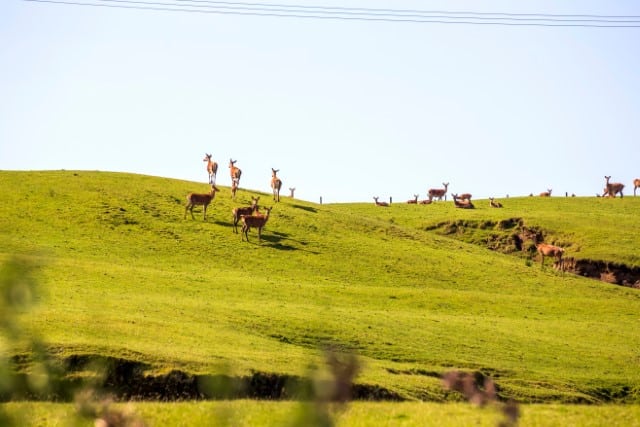
A significant factor that impacts how many deer may be in a given area is how often hunters go there. The more often hunters hunt in an area, the less likely deer are to appear.
The local population of deer predators and prevalence of diseases that impact deer can also make a difference.
Hunters usually have to hunt in different areas throughout the year, to have a higher chance of spotting a deer.
The average density of deer in an acre of wild land varies from forest to forest, but you can get a good idea based on how fruitful the hunting results are.
Permitted Number of Deer Kills Per Acre
The limit for how many deer can be hunted per acre depends on the size of the hunting land. The limits are in place to prevent overhunting and allow deer to continue to survive in the area.
The average permitted number of deer kills per acre is one doe or buck for each hunter. This number depends on a variety of factors, including:
- Deer movement
- The state you’re in
- Number of treestands
Deer movement refers to where deer are living and feeding, and it’s determined by counting the number of deer beds and where the deer go.
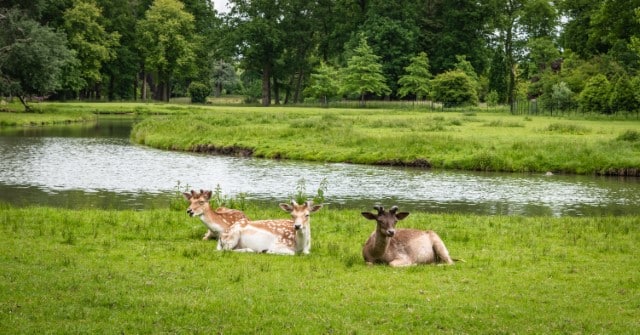
The more deer are on the move or inhabit the area, the more you can kill for hunting. The movement of deer can be searched by looking up the area and any deer movement that’s recorded.
State regulations for how many deer you can kill vary from state to state. For example, if the state you’re in has a higher number of hunters, you probably won’t be able to kill as many deer.
Make sure you get acquainted with your state’s hunting regulations before you start hunting in that state.
Lastly, the amount of treestands refers to the areas where hunters can sit down and watch for deer passing by.
The average number of treestands per acre of land is the following:
- 8-10 stands for 40-50 acres of land
- 12-16 stands for 100 acres of land
- 18-20 or more for 500 acres of land or more
A higher number of treestands in a hunting area can help you determine how many deer you can kill. The chart above gives you a good rule of thumb for how many deer you can kill per acre in the wild.
Final Thoughts About Deer Population per Acre
When it comes to hunting, knowing how many deer you can kill per acre will help you hunt responsibly and safely.
If you’re a deer farmer, you’ve got to know the average number of deer that can survive per acre in order to keep a healthy and happy herd.
It will also help you plan out your land to better accommodate your herd’s needs.
Do you want to learn more about having a deer farm? Take a look at our complete guide to deer farming before you go.

